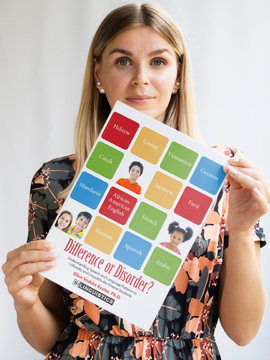Evidence-based Elicitation and Analysis Using the SLAM Materials
$22.00

Course Type: Video – 1 1/2 hours
Decades of research has shown that standardized language tests and measurements contain serious cultural and linguistic biases so they cannot be relied on when testing diverse students. Thankfully, there are efficient and accurate non-standardized ways to assess language so that professionals can be confident in the diagnostic decisions they are making.
Join Dr. Cate Crowley of Columbia University in this video-rich demonstration of the effectiveness of the School-age Language Assessment Measures (SLAM) for speech-language evaluations. The SLAM materials offer a research-based, culturally-responsive approach to language sample analysis, that can be completed with reasonable demands on a clinician’s time and skill set.
Additional Information
| Population | Early Childhood, School Age |
|---|---|
| Duration | 1.5 hours |
| Credit | .15 Continuing Education Units |
| Topics | Diversity, Equity, & Inclusion (DEI), Evaluations, Exp/Rec Language |
| Format | Video |
Dr. Cate Crowley is Professor of Practice in Teachers College, Columbia University’s CSD program, where she directs its bilingual/multicultural focus and the Bilingual SLP Extension Institute. An ASHA Fellow, her website, leadersproject.org, offers free resources to improve the quality of disability evaluations including online courses, test reviews, model evaluations, the language elicitation materials the School-age Language Assessment Measures and the Pre-SLAM. Cate is a sequential trilingual in Spanish and French. In addition to her disability evaluation work, she has been traveling a great deal post-covid providing cleft palate speech therapy trainings in Africa, Latin America and Asia. All the assessment and treatment materials, in over 30 different languages, are free to copy and download, as are the online courses that can lead to ASHA CEUs.
Financial Disclosure: Dr. Cate Crowley, Ph.D., CCC-SLP received a speaking fee from Bilinguistics.
Non-Financial Disclosure: None to disclose
In this session, Dr. Crowley demonstrates through video case studies the effectiveness of the School-age Language Assessment Measures (SLAM) in speech-language evaluations. The SLAM materials offer a research-based, culturally-responsive approach to language sample analysis, that can be completed with reasonable demands on a clinician’s time and skill set.
It is impossible to ensure objective, accurate, and unbiased disability evaluations without using culturally-responsive and evidence-based assessment materials. Unfortunately, most graduate students continue to be taught that an evaluation should be based on the results of omnibus language and vocabulary tests, the acquisition of Brown’s morphemes, and perhaps MLUs, Number of Different Words, and Type Token Ratios. This continues to be true despite decades of research showing that these standardized language tests and measurements contain serious cultural and linguistic biases, and lack adequate construct validity (McCauley & Swisher, 1984; Peña & Quinn, 1997; Stockman, 2000; Horton-Ikard & Weisman, 2007; Hendricks & Adlof, 2017; Barragan et al. 2018).
Given the research and the standard for evaluations set by the federal law, these approaches are biased and not valid (Nair, et al., 2023). According to IDEA (2004), the federal law that sets the standard for school-age evaluations, evaluations must “gather relevant functional, developmental and academic information” (20 U.S.C. Sec. 1414(b)(2)), using a variety of assessment tools and instruments. They must also meet additional standards including that assessment materials be used for purposes for which they are “valid and reliable” (20 U.S.C. 1414(3)(A)(iii)) and “not discriminatory on a racial or cultural basis” (20 U.S.C. 1414(3)(A)(i)), and be able to distinguish a true disability from lack of adequate instruction in reading or math or from “Limited English Proficiency” (20 U.S.C. 1414 (5)).
To achieve diagnostic accuracy–the efficacy of a particular assessment instrument in identifying a disorder–a student cannot be penalized for their cultural, linguistic, or socio-economic background. (Crowley & Baigorri, 2019; Castilla-Earls, et al., 2020; Barragan, et al., 2018). Yet, students from lower socio-economic backgrounds and students who speak varieties of English, other than General American English, are routinely misidentified as having a language disorder using the CELF-5, CELF4-Spanish and vocabulary tests (Hendricks & Adlof, 2017; Barragan, et al., 2018; Stockman, 2000). In fact, when we seek to identify a true language disorder, the key is to determine whether the student has acquired the linguistic varieties that they have been exposed to in their home and community, as influenced by their particular language acquisitional history (Wolfram, Adger & Christian, 1999).
Among a “small number of assessments,” the School-age Language Assessment Measures (SLAM) materials have been found to minimize cultural and linguistic biases (Washington, et al., 2020), and are part of an initiative intended to put quality assessment and treatment materials in the hands of clinicians.
A language sample analysis is an important part of a comprehensive, and accurate, speech-language disability evaluation, but is often not included because clinicians find them so time consuming (Pavelko, et al., 2016). However, using the SLAM materials, clinicians elicit a short, approximately four-minute language sample. These assessment materials are evidenced-based and are elicited through expository language and persuasive language (Nippold, et al., 2005; Nippold, et al., 2008; Nippold, et al., 2017). The analytical framework uses the dialect-neutral indices identified by Burns et al. (2012). These include temporal, relational, and causal cohesion, theory of mind, taking perspectives, false beliefs, making meaningful predictions, making inferences, and problem solving. Because there are no specific or required answers to the questions as long as the answers are reasonable, students can express their own cultures, values, and viewpoints. All three elements are needed for evidence-based practice, and are incorporated into the SLAM materials (ASHA, 2005).
This session focuses on language samples elicited from children in early elementary school from a variety socio-economic, cultural, and linguistic backgrounds, including bilingual students. Through the use of videos and case studies, participants learn how to organize and analyze the language samples elicited using the SLAM Guidelines for Analysis and then how to determine whether the child is “likely typical,” “likely needs support,” or “needs further probing” based on the results of the SLAM Scoring Guidelines.
All the SLAM materials, including the Guidelines for Analysis, the Scoring Guidelines, and the new Preschool Language Assessment Measures are available at leadersproject.org. This website offers everything for free download and copying. Dr. Cate Crowley, is the director of the website that is located in Columbia University. The website regularly receives over 25,000 visits per month from over 130 countries. The SLAM and Pre-SLAM materials are available in 20 different languages for free downloading and copying at leadersproject.org.
Participants will be able to:
1. Describe one freely available approach to evidence-based and culturally responsive language sample analysis, and how to access these free materials
2. Classify sentences as simple, compound, and/or complex including identifying dependent clauses as relative, adverbial, or noun clauses
3. Identify four dialect-neutral approaches to analyze inferencing, problem-solving, and causal, temporal, and referential cohesion in language samples for disability evaluations
Time-Ordered Agenda
10 minutes Overview of current practice in language assessment of school-age children
20 minutes Evidence-based approach of language elicitation and analysis that is consistent with the research, feasible given clinician’s time, and incorporates the child/student’s and their family’s values and cultures
20 minutes Building skills in analyzing language samples and dialect neutral markers of narrative cohesion and evaluation
20 minutes quantifying language sample outcomes using the SLAM Guidelines for Analysis and Scoring Parameters
20 minutes Moderated Q&A
Need CEUs?

 Share
Share
 Tweet
Tweet
 LinkedIn
LinkedIn
 Pin
Pin
 Email
Email







